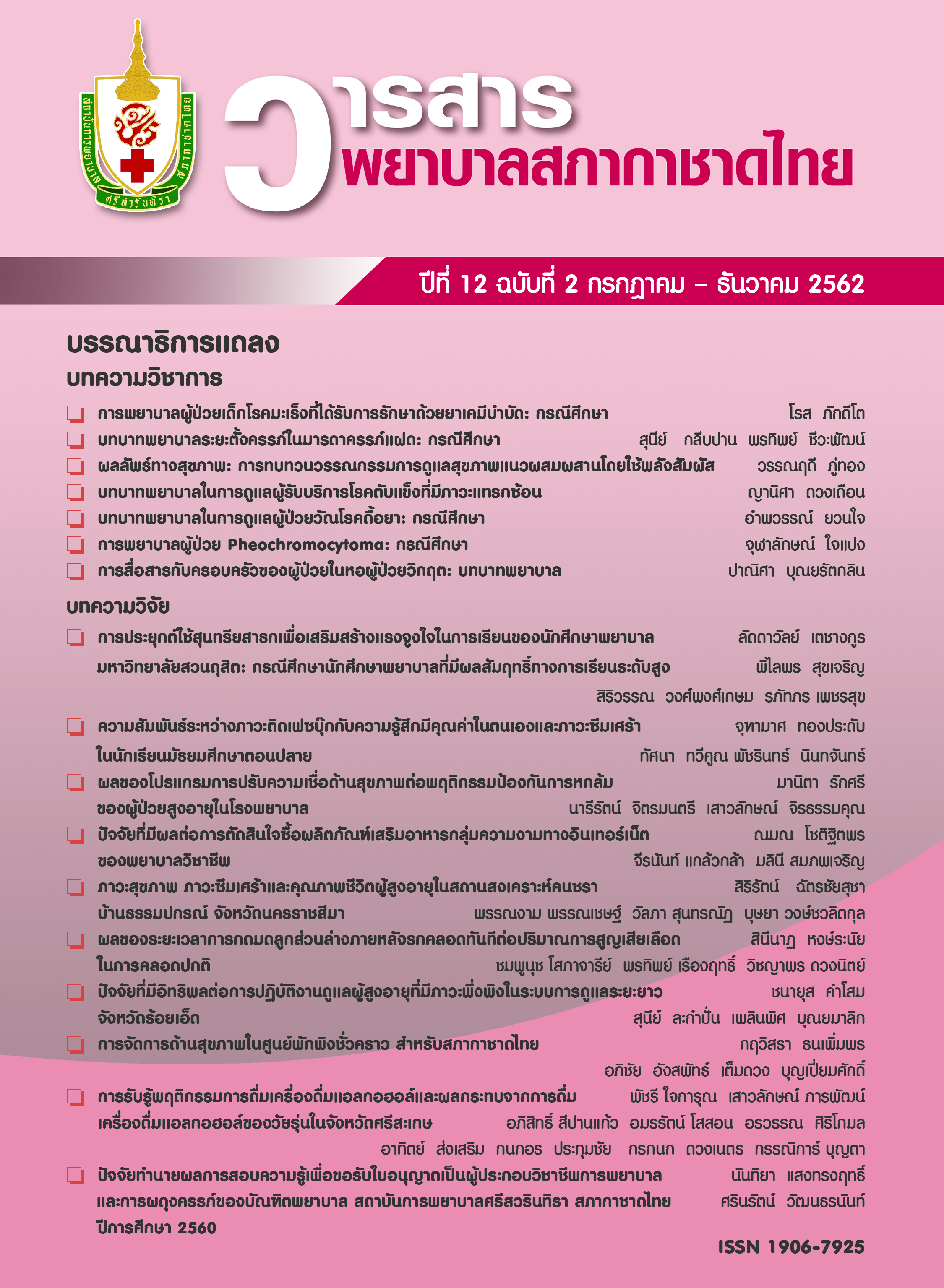ผลของระยะเวลาการกดมดลูกส่วนล่างภายหลังรกคลอดทันที ต่อปริมาณการสูญเสียเลือดในการคลอดปกติ
คำสำคัญ:
กดมดลูกส่วนล่าง, การสูญเสียเลือดบทคัดย่อ
การวิจัยครั้งนี้เป็นการวิจัยแบบกึ่งทดลอง เพื่อศึกษาระยะเวลาการกดมดลูกส่วนล่างภายหลังรกคลอดทันทีต่อปริมาณการสูญเสียเลือดใน 1 ชั่วโมงหลังคลอด กลุ่มตัวอย่างเป็นผู้คลอดโรงพยาบาลแห่งหนึ่งในจังหวัดเชียงราย สุ่มตัวอย่างอย่างง่ายจากตัวอย่าง จำนวน 90 คน แบ่งเป็น 3 กลุ่ม กลุ่มละ 30 คน โดยกลุ่มทดลองจะได้รับการกดมดลูกส่วนล่างนาน 20 นาที กลุ่มเปรียบเทียบจะได้รับการกดมดลูกส่วนล่างนาน 10 นาที ภายหลังรกคลอดทันที และกลุ่มควบคุมจะได้รับการพยาบาลตามปกติ เครื่องมือที่ใช้ในงานวิจัยประกอบด้วยคู่มือการกดมดลูกส่วนล่างภายหลังรกคลอด ถุงตวงเลือด เครื่องชั่งน้ำหนักแบบดิจิตอล และแบบบันทึกปริมาณการเสียเลือด วิเคราะห์ข้อมูลโดยใช้สถิติพรรณนา และการวิเคราะห์ความแปรปรวนทางเดียว
ผลการวิจัยพบว่า กลุ่มทดลองมีค่าเฉลี่ยปริมาณการสูญเสียเลือดภายหลังรกคลอดน้อยกว่ากลุ่มควบคุมอย่างมีนัยสำคัญทางสถิติที่ระดับ .05 (p<.05) กลุ่มเปรียบเทียบมีค่าเฉลี่ยปริมาณการสูญเสียเลือดภายหลังรกคลอดน้อยกว่ากลุ่มควบคุมอย่างมีนัยสำคัญทางสถิติที่ระดับ .01 (p<.01) ส่วนกลุ่มเปรียบเทียบและกลุ่มทดลองมีค่าเฉลี่ยปริมาณการสูญเสียเลือดภายหลังรกคลอดไม่แตกต่างกัน
การศึกษาครั้งนี้ แสดงให้เห็นว่า การกดมดลูกส่วนล่างภายหลังรกคลอดทันทีนาน 10 นาที ร่วมกับการพยาบาลตามปกติ สามารถลดปริมาณการสูญเสียเลือดภายหลังรกคลอดได้
เอกสารอ้างอิง
2. World Health Organization. WHO recommendations for the prevention and treatment of postpartum haemorrhage. Italy: WHO; 2012.
3. Bureau of Policy and Strategy, Ministry of Public Health. Statistical Thailand 2016. [Internet]. 2016 [cited 2016 May 24]. Available from http://bps.ops.moph.go.th/Healthinformation (in Thai)
4. Maternal and Child Health Board, Region 1 Health Provider. CIPO: reduce maternal mortality [Internet]. 2017 [cited 2017 Feb 2]. Available from http://www.chiangmaihealth.go.th>document (in Thai)
5. Shields LE, Goffman D, Caughey AB. ACOG practice bulletin: clinical management guidelines for obstetrician-gynecologists. Obstet Gynecol 2017;130(4):e168-e86.
6. Chantrapitak W, Srijuntuek K, Wattanaluangarun R. The efficacy of lower uterine segment compression for prevention of early postpartum hemorrhage after vaginal delivery. J Med Assoc Thai 2011;94(6):649-56.
7. Caroli G, Cuesta C, Abalos E, Gulmezoglu AM. Epidemiology of postpartum hemorrhage: a systematic review. Best Pract Res Clin Obstet Gynaecol 2008;22(6):999-1012.
8. Anusornteerakul S. First two hours postpartum hemorrhage prevention: midwives’s role. Journal of Nursing Science & Health 2014;37(2):155-162. (in Thai)
9. Maternal and Child Health Board Chiangrai province. Problem solving for reduce maternal mortality from postpartum hemorrhage [Internet]. 2016 [cited 2017 Feb 2]. Available from http://www.rh1.go.th>site>upload>news (in Thai)
10. Masuzawa Y, Yaeko K. Uterine activity during the two hours after placental delivery among low-risk pregnancies: an observational study. J Matern Fetal Neonatal Med 2017;30(20):2446-51
11. Yuksel H. A novel approach to primary lower uterine segment atony. Taiwan J Obstet Gynecol 2015;54:452-4.
12. Srisawat C. Hemostasis [Internet]. 2012 [cited 2018 Apr 12]. Availble from: http://www.si.mahidol.ac.th/department/biochemistry/ home/md/lecture/ Hemostassis_lecture_note.pdf (in Thai)
13. Kanitsap N. Hemostasis and fibrinolytic system. In: Kanitsap N. editor Basic hematology in general pactice. Samut Prakan: Nextstep D-sign; 2011. P. 121-35 (in Thai)
14. Anunsakunwat W, lamurairat W, Boonyoung P. Lower uterine segment compression for 20 minutes to prevent early postpartum hemorrhage. J Med Assoc Thai 2018;101(9):1151-6.
15. Chantrapitak W, Anunsakunwat W, Sritippayawan S, Lojindarat S, Srijuntuek K, Wattanaluangarun R. Lower uterine segment compression (LUSC), procedure for treatment and prevention of postpartum hemorrhage. Charoenkrung Pracharak Hospital Journal 2014;10(1):45-52. (in Thai)
16. Chongsomchai C. Postpartum hemorrhage. In: Kovavisarach E, Promsonthi P, Junrachakul B. editors. Serious obstetric crisis. Bangkok: Three-D Scan; 2012. p. 135-47 (in Thai)
17. Golmakani N, Khalegnezhad K, Dadgar S, Hashempor M, Baharian N. Comparing the estimation of postpartum hemorrhage using the weighting method and national guideline with the postpartum hemorrhage estimation by midwives. Iran J Nur Midwifery Res 2015;20(4):471-5.
18. Polit DF, Hungler BP. Nursing research principle and methods. 7th ed. Philadelphia: Lippincott Williams & Wilkins; 2004.
ดาวน์โหลด
เผยแพร่แล้ว
ฉบับ
ประเภทบทความ
สัญญาอนุญาต
เนื้อหาบทความหรือข้อคิดเห็นต่างๆ ในวารสารพยาบาลสภากาชาดไทยนี้ เป็นความคิดเห็นของผู้เขียนบทความ ไม่ใช่ความเห็นของกองบรรณาธิการ หรือสถาบันการพยาบาลศรีสวรินทิรา สภากาชาดไทย






